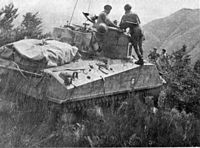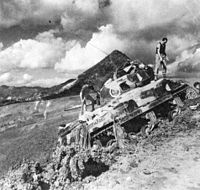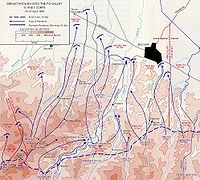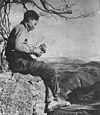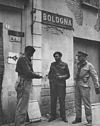
The 2nd New Zealand Division, initially the New Zealand Division, was an infantry division of the New Zealand Military Forces during the Second World War. The division was commanded for most of its existence by Lieutenant-General Bernard C. Freyberg. It fought in Greece, Crete, the Western Desert and Italy. In the Western Desert Campaign, the division played a prominent role in the defeat of German and Italian forces in the Second Battle of El Alamein and the British Eighth Army's advance to Tunisia.
The 1st South African Infantry Division was an infantry division of the army of the Union of South Africa. During World War II the division served in East Africa from 1940 to 1941 and in the Western Desert Campaign from 1941 to 1942. The division was disbanded on 1 January 1943, for conversion into what would become the 6th South African Armoured Division. The division was also briefly active after the war from 1 July 1948 to 1 November 1949.
The South African 2nd Infantry Division was an infantry division of the army of the Union of South Africa during World War II. The division was formed on 23 October 1940 and served in the Western Desert Campaign and was captured by German and Italian forces at Tobruk on 21 June 1942. The remaining brigade was re-allocated to the South African 1st Infantry Division.

The 90th Light Infantry Division was a light infantry division of the German Army during World War II that served in North Africa as well as Sardinia and Italy. The division played a major role in most of the actions against the British Eighth Army in the Western Desert Campaign and eventually surrendered to the Allies in the final stages of the Tunisia Campaign in May 1943. It was re-constituted later in 1943 and deployed to Sardinia and when the expected Allied invasion of Sardinia failed to materialise, the division was moved to Italy. It was engaged in actions against the Allies in Italy from 1943 to April 1945 when the division was listed as "destroyed" in the Po River valley.
The Liverpool Welsh, under various guises, was a unit of Britain's Volunteer Force and Territorial Army (TA) associated with the King's Liverpool Regiment. It served as a tank regiment in the Western Desert and Italian Campaigns in the Second World War, as a security force during the Greek Civil War, and as a heavy anti-aircraft artillery regiment postwar.
The 150th Infantry Brigade was an infantry formation of the British Army that saw active service in the Second World War. A 1st Line Territorial Army brigade, it was part of the 50th (Northumbrian) Infantry Division. It served in the Battle of France and was evacuated from Dunkirk. Later it served in the Middle East and was overrun and forced to surrender during the Battle of Gazala in the North African Campaign. For almost 72 hours during the battle the 150th Brigade and the 44th Royal Tank Regiment held out against Erwin Rommel's concentrated attacks, without any support. On 1 June the German Army finally forced their surrender. The brigade was not reformed.

The 22nd Armoured Brigade was an armoured brigade of the British Army that saw service during and after the Second World War. The brigade was formed on the outbreak of war on 3 September 1939 from Territorial Army (TA) armoured regiments. It saw a considerable amount of action during the war, beginning with the Western Desert Campaign where it was engaged in Operation Crusader and at the Battles of Gazala, Mersa Matruh, First Alamein and Alam el Halfa. It then joined the 7th Armoured Division for the Second Battle of El Alamein. It remained part of 7th Armoured for the rest of the war, including the campaigns in Tunisia, Italy and North West Europe. It continued in the postwar TA until 1956. The brigade's identity was re-established in the Regular Army between 1981 and 1993.

The Battle of the Argenta Gap was an engagement which formed part of the Allied spring 1945 offensive during the Italian campaign in the final stages of the Second World War. It took place in northern Italy from 12 to 19 April 1945 between troops of British V Corps commanded by Lieutenant-General Charles Keightley and German units of LXXVI Panzer Corps commanded by Lieutenant General Gerhard von Schwerin.

The Italian invasion of Egypt was an offensive in the Second World War, against British, Commonwealth and Free French forces in the Kingdom of Egypt. The invasion by the Italian 10th Army ended border skirmishing on the frontier and began the Western Desert Campaign (1940–1943) proper. The Italian strategy was to advance from Libya along the Egyptian coast to seize the Suez Canal. After numerous delays, the scope of the offensive was reduced to an advance as far as Sidi Barrani and the engagement of any British forces in the area.

The Middlesex Yeomanry was a volunteer cavalry regiment of the British Army originally raised in 1797. It saw mounted and dismounted action in the Second Boer War and in the First World War at Gallipoli, Salonika and in Palestine, where one of its officers won a Victoria Cross at the Battle of Buqqar Ridge and the regiment rode into Damascus with 'Lawrence of Arabia'. Between the world wars the regiment was converted to the signals role and it provided communications for armoured formations in the Second World War, including service in minor operations in Iraq, Palestine, Syria and Iran, as well as the Western Desert, Italian and North-West European campaigns. It continued in the postwar Territorial Army and its lineage is maintained today by 31 Signal Squadron, Royal Corps of Signals, which forms part of the Army Reserve.
The 2nd South African Infantry Brigade was an infantry brigade of the army of the Union of South Africa during World War II. The Brigade formed part of the 1st South African Infantry Division and was formed on 13 August 1940. It served in East Africa and the Western Desert and was disbanded on 1 January 1943.

The 1st Devonshire Artillery Volunteers and its successor units served in the British Army's Reserve Forces from 1859 to 1961. During World War I it carried out garrison duty in British India but went on to see active service in the Third Anglo-Afghan War. Converting to an air defence role before World War II its units participated in the Norwegian campaign and the Dunkirk evacuation, the Battle of Britain and then the campaigns in North Africa, Italy, and Burma
The 1st Renfrew and Dumbarton Artillery Volunteers was a part-time unit of the British Army's Royal Artillery founded in Scotland in 1860. During the First World War, it served with 51st (Highland) Division at the Battle of the Somme before being broken up. In the Second World War, the regiment saw action in the Battle of France, in the campaigns in North Africa, Sicily, Italy, the Greek Civil War and in North West Europe. It continued in the postwar Territorial Army until 1969.

2nd Army Group Royal Artillery was a brigade-sized formation organised by Britain's Royal Artillery (RA) during World War II to command medium and heavy guns. It served in the final stages of the Tunisian Campaign and throughout the Italian Campaign. It reformed in the Territorial Army in the 1950s to command air defence units.
The 1st Flintshire Rifle Volunteers, later 5th (Flintshire) Battalion, Royal Welch Fusiliers, was a Welsh unit of the British Army's auxiliary forces. First raised in 1860, it fought as infantry at Gallipoli), in Egypt and Palestine during the First World War. Converted to the anti-tank role, it fought in the Battle of France, the Western Desert and Italy in the Second World War. It continued in the postwar Territorial Army until amalgamated with a neighbouring unit in 1956.

61st Light Anti-Aircraft Regiment was an air defence unit of Britain's Royal Artillery formed during the Second World War. Its component Territorial Army batteries, both from London, had already seen action in the Battle of France before the regiment was formed in 1940. It went on to serve with armoured formations in the Western Desert Campaign, including the Battle of Gazala. It was broken up in the Middle East in 1944 to provide infantry reinforcements for the Italian Campaign.

The 56th Light Anti-Aircraft Regiment, Royal Artillery, was a Royal Artillery (RA) air defence unit of Britain's part-time Territorial Army (TA) raised as a duplicate unit just before the outbreak of the Second World War. It served in the Norwegian Campaign and then joined 8th Armoured Division. It was sent to Egypt and participated in the Second Battle of El Alamein and the subsequent pursuit across North Africa. It then fought in the Italian Campaign, including defending the Salerno and Anzio beachheads. It often operated under US command, on one occasion in an anti-tank role. The regiment reformed as heavy AA artillery in the postwar TA and continued until 1955 when it merged with other units in Lancashire.

The Manchester Artillery is a Volunteer unit of the British Army first raised in the City of Manchester in 1860, whose successors continue to serve in the Army Reserve today. It became a brigade of the Royal Field Artillery in the Territorial Force in 1908, and in World War I it served in Egypt in 1915–17 before being broken up. Its second line unit went to the Western Front in 1917, seeing action at Ypres, against the German Spring Offensive, and leading the pursuit in the Allies' victorious Hundred Days Offensive. Just before World War II the Manchester Artillery again formed a duplicate. While the parent regiment served in the Battle of France including the Dunkirk evacuation, and later in the Middle East and the Italian campaign, its duplicate fought in Normandy and North West Europe. Both regiments were reformed postwar, but after a number of amalgamations they and several other Manchester-based units were reduced into 209 Battery in the present-day Army Reserve.
The 1st Worcestershire Artillery Volunteers was a part-time unit of Britain's Royal Artillery dating back to 1865. As part of the Territorial Force it served on the Western Front and in Italy during World War I. In World War II it served in the Battle of France and was evacuated from Dunkirk. It later fought in Tunisia and Italy. After a series of postwar mergers, it continues as a battery in today's British Army Reserve.

The 2nd Battalion, Tower Hamlets Rifles, was a Territorial Army unit of the British Army during World War II. It fought as a motor battalion in the Tunisian campaign, including the Run for Tunis and Battle of Kasserine Pass, and in the Italian Campaign from Monte Cassino to the Apennines, including the seizure of the Muraglione Pass.






